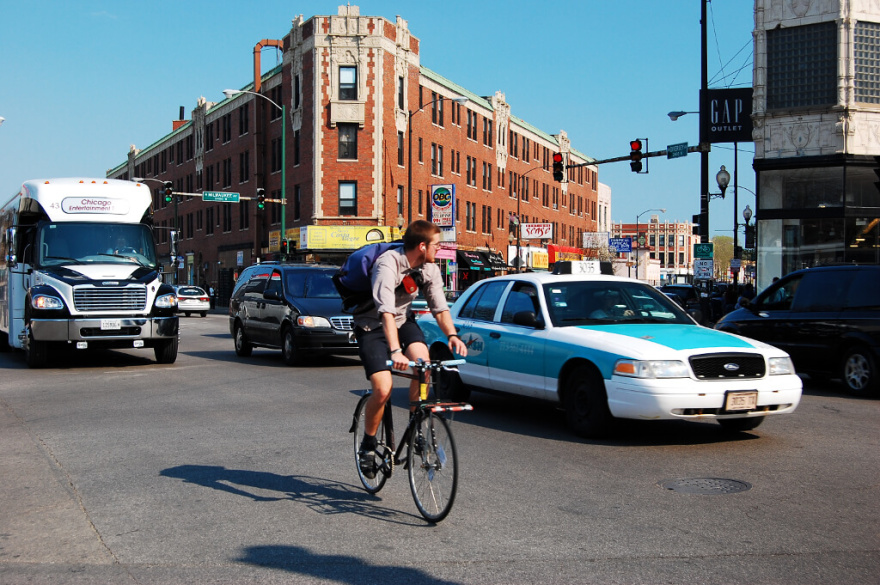Autumn Gear Guide
Find inspiration in our Gear Guide that will keep you out on your bike through wind or rain.
Download NowThe Delaware Department of Transportation has removed all “Share the Road” signs in favor of signs stating that cyclist “May Use Full Lane.”

Photo By: Eric Allix Rogers
In November, 2014, the Delaware Department of Transportation announced that they would cease to use the “Share the Road” plaque on license plates and uninstall all “Share the Road” traffic signs across the state. Many assumed that the cycling advocacy group, Bike Delaware, would be infuriated by the announcement. As it turns out, Bike Delaware were the ones to request the signs’ removal. But why?
Despite its good intentions, the “Share the Road” directive had some serious problems – its issues sprung from a general sense of confusion and disagreement between road users on who the sign was directed at, at what it was telling them to do.
For bicyclists in Delaware (and elsewhere), “Share the Road” was interpreted to be for motorists, telling them to just, you know, be cool, give people on bikes some space. But for drivers, the sign was there to tell cyclists: “Don’t slow me down, stay over to the side so I can pass.” After years of yelling “Share the Road!” at each other, it was finally realized that not only does the sign not help, it actually contributes to conflict between the various modes.
As most bicyclists have probably experienced, a huge conflict for bikers and motorists is when the biker “takes the lane” (i.e. cycling in the middle of a travel lane). As a driver, it is understandable to become a little impatient with the slower pace of the person biking in front of them. However, there is a reason cyclists will sometimes stay in the center of a lane; riding at the right hand edge of a travel lane is an invitation for cars behind them to pass. On narrow streets, most people on bikes are not comfortable being passed in their lane, so riding in the center of the travel lane ensures that motorists will only be able to pass by changing lanes or briefly moving into the oncoming traffic line.
While “Share the Road” was originally intended to make this clear to motorists, it ended up having the opposite effect. Bike Delaware eventually concluded that “Share the Road” is just ‘feel good’ placation without any safety benefits. Their advocacy led to the state dumping the ambiguous message in favor of a more precise one: “Bicyclists May Use Full Lane.”
Recently, researchers George Hess and M. Nils Peterson of North Carolina University conducted an online survey of nearly 2,000 people to find out what various road signs meant to them, and their findings corroborate what Bike Delaware has been saying for years. Survery respondents were shown pictures of various traffic scenarios and street designs, and asked to interpret those signs in those contexts.
When confronted with the “Share the Road” message, respondents did not feel cyclists had the right to occupy a full lane. Sharrows, on-street painted markings to indicate the best line of travel for bikes, only helped a little. The survey did conclude, however, that the sign indicating that bicyclists “May Use Full Lane” was the clearest indication of a cyclist’s equal right to the road.
On a four-lane road, both sharrows and the “May Use Full Lane” sign doubled the amount of people who felt in that context that cyclists are allowed to bike in the center of the lane. Regardless, on two-lane roads, neither sharrows nor “Share the Road” signs communicated that motorists should wait for a safe gap in traffic to pass in the adjacent lane effectively. The “May Use Full Lane” sign, however, did.
It was acknowledged by Hess and Peterson that the pool of respondents may not have represented a truly objective sample group; respondents were recruited via Twitter and appeared to bike more and drive less than the typical American. Subsequently, given the skew towards bikers in the survey, the results suggest that, if anything, the average American is more confused by the “Share the Road” sign than the survey indicates.
The “Bicyclists May Use Full Lane” signs are a huge improvement in making traffic situations more clear for the motorist and cycler alike over the previous signage. While the protected bike lanes are under construction and we’re still left “sharing the road,” at least it’s clear: we do, in fact, get to use the full lane.
Find inspiration in our Gear Guide that will keep you out on your bike through wind or rain.
Download Now
How many pickup truck drivers have yelled ‘share the lane’ at me as they attempt to pass unsafely?
When there is a massive power imbalance, this phrase is a license to push cyclists to the curb.
Great
Comments are closed.